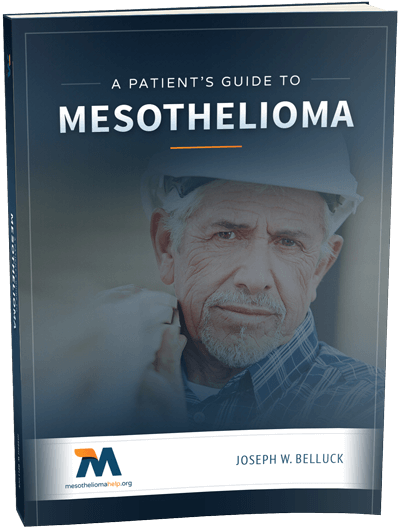Category: Nurse’s Corner
Cryoablation is One Option for Managing Recurrent Mesothelioma
What can doctors do for patients when their mesothelioma recurs? Although many believe there are no options, recent advances have changed that. One of the options available is cryoablation. Cryoablation is a treatment that is being used for mesothelioma recurrences that involve the chest wall to help relieve pain and to improve the quality of life for mesothelioma survivors.
Cryoablation consists of controlled freezing to destroy cancer tumors in a safe and quick manner. It is sometimes used as a primary treatment for cancer of the kidney, liver, lung and prostate. Cryoablation can be used to relieve pain that the tumor might be causing by pressing on other organs.
An English physician, James Arnott, is credited with being the first to use cold to destroy tissue, as early as the 1800s. He used a combination of ice and salt to destroy unhealthy tissue. The ancient Egyptians were the first to use cold to treat swelling, showing the roots of the procedure in some form go way back.
Cryoablation is usually administered percutaneously, or through the skin, directly into the area of the diseased tissue. Through a wand-like device, a cryoprobe is inserted, and a gas is used to freeze the tissue. The tissue is then allowed to thaw. This cycle may be repeated several times during the same treatment session. Ablation occurs when the tissue has been frozen and the blood coagulates interrupting blood flow to the tissue, causing ischemia and cell death.
An April 2013 study from UCLA , “Role of percutaneous cryoablation in management of recurrent mesothelioma following lung sparing pleurectomy and decortications,” reports that for localized malignant pleural mesothelioma recurrences, cryoablation following surgery can be performed safely as an outpatient procedure with minimal morbidity, a very high efficacy rate, and improved overall survival.
Recently, the procedure is being performed in other mesothelioma centers. Ask your mesothelioma care team if this procedure is right for you. The UCLA study was done on an outpatient basis, but other institutions have patients stay one night in the hospital. The procedure is usually done under general anesthesia.
Here is another promising adaptation of an established procedure to improve the quality of life and survivorship for mesothelioma patients!

Mesothelioma Is One Cause of Night Sweats
Mesothelioma patients sometimes complain about night sweats. It can be one of the symptoms that brings them to the doctors. Night sweats can be a harmless, annoying, situation, or a symptom of a serious health issue.
Night sweats are defined as drenching sweats that require the patient to change bedclothes. Doctors refer to true night sweats as severe hot flashes occurring at night that are not related to an overheated environment. Night sweats have various known causes.
Some of the conditions responsible for night sweats include:
- Cancer. Night sweats can be an early symptom of some cancers especially lymphoma. When it is cancer, night sweats are not usually the only symptom, other symptoms could be fever and unexplained weight loss.
- Hypoglycemia or low blood sugar. Patients taking insulin or oral anti-diabetic medications may experience nighttime hypoglycemia accompanied by sweating.
- Idiopathic hyperhidrosis. A condition characterized by excessive sweat production with no obvious medical explanation.
- Infections. Tuberculosis is the infection most notoriously associated with night sweats. Bacterial infections, such as endocarditis, (inflammation of the heart valves), osteomyelitis, (inflammation within the bone), and abscesses located in the appendix and tonsils, and HIV infection are other potential causes for night sweats.
- Medications. Antidepressants are one type of medication that can lead to night sweats.
- Menopause and peri-menopause. A very common cause of night sweats in women. Also caused by hormonal changes that occur in adolescence and pregnancy.
If you go to a doctor with night sweats as a concern, there are numerous questions you will be asked. In addition, you will more than likely undergo blood work. Along with blood work, your doctor may order a chest x-ray and a thyroid stimulating hormone test.
Evaluating and determining the cause for night sweats can be difficult, to say the least. If the first round of tests come back negative, your doctor may consider CT scans of your chest and abdomen, and possibly a bone marrow biopsy.
If you were exposed to asbestos in the past, make sure to let your doctor know. While night sweats, as you see, can be caused by many issues, an asbestos-related disease could be an underlying cause.
If you have any questions about any aspect of your mesothelioma care, please email me at [email protected].

Alarming, Yet Uplifting Information in PBS Cancer Documentary
History has taught us many lessons. Studying the past can help us progress, and can prevent us from repeating mistakes. Recently on PBS, there was an excellent history and status report on cancer: ‘Cancer: The Emperor of All Maladies,’ written by oncologist Siddhartha Mukherjee and produced by Ken Burns. Mukherjee’s reasons for writing the book was because he was confused on where we are now versus where we have been in the treatment of cancer. How could we talk about the future, if we don’t know the past?
Cancer has been recognized as a disease for centuries. Part of that time it was thought that nothing could be done to treat it, and there was no cure for it. Cancer was thought of as a disease with “too much humors,” balance of the body was out of synch.
During this three-part documentary, many fascinating ideas were explored, and future directions were explained in a way that could be understood by all of us. The fact that more people will die from cancer in the next two years than from all the wars that have ever been fought, is a sobering reality.
The numbers alone are staggering:
- 1.7 million Americans are diagnosed with cancer each year;
- 1 in 2 men will have cancer in their lifetime;
- 1 in 3 women will have cancer in their lifetime;
- 600 thousand people die a year from cancer.
Although the numbers are frightening, the documentary was uplifting. To see where we have been, and how far we have come in cancer care today is amazing. To gain more insight into cancer and the progress being made, visit the PBS website to find out where you can watch the series.
Know more about Mesothelioma and how you can deal with it.

Patients Often Deal With Blood Clots
Blood clots are one side effect mesothelioma patients must deal with. Patients with cancers that occur in the lungs and abdomen, such as mesothelioma, are at greater risk of developing blood clots. Although cancers that have spread from their original site, or metastasized, can put patients at risk too. Often physicians look at age, race and ethnicity to determine risk factors, but treatments including surgery, chemotherapy and radiation are all contributing factors. The good news is that blood clots can be treated.
A blood clot can also be called a thromboembolism. There several different types that may develop in cancer patients. One type is a venous thromboembolism that develops in a vein. A deep vein thrombus, or a DVT, usually occurs in the leg, thigh or pelvis; whereas, a pulmonary embolism is a blood clot that has traveled to the lung from another area, and can be life-threatening. Thirty eight percent of patients who have had surgery will be diagnosed with a blood clot, but they are treatable.
Blood clot symptoms include pain, swelling and redness in the affected area. Usually these are seen in the calf, leg or thigh. The symptoms of pulmonary embolism are shortness of breath, chest pain, and rapid breathing and heartbeat. Sometimes the person will also cough up blood. If you experience any of these conditions, you need to notify emergency personnel immediately.
Patients who have pulmonary embolisms are usually treated with Heparin for 5-10 days and then are converted to an oral medication. Depending on your treatment, doctors may order a non-invasive ultrasound of your legs, pelvis, arms and neck. It is easy and painless- a warm gel is applied to the affected area, and the ultrasound handle is placed on the area being scanned. Attached to the device is a monitor that will show your vessels and will reveal if there is a clot in one of your extremities or pelvis. If your physician is suspicious that you may have a pulmonary embolus, you will have a CT scan that specifically looks for a clot in your lungs.
Anticoagulants are the drugs that help break up these clots and stop other clots from forming. Compression stockings can also be used (they are a type of support hose). If you are receiving inpatient care, you may receive therapy to get you walking to keep the blood circulating as much as possible. Often times people have pneumatic boots on that help promote circulation while in bed. This is a small machine that has plastic leggings that squeeze your legs intermittently. It is painless, and most patients don’t mind them.
This may all sound overwhelming, but I want to cover information about issues you may have to manage as a mesothelioma patient. Always keep your medical team informed of any pain or symptoms that suddenly appear.
If you have any questions about any aspect of your mesothelioma care, please email me at [email protected].
Nurse Inspired by Mesothelioma Survivor Who Comforts Other Patients
Survivors of mesothelioma and their stories are inspirational. From their stories we gather strength and renewed purpose. At a recent conference, a mesothelioma survivor talked about her journey, her leap of faith, and her life today, as well as the everyday challenges she now faces living with mesothelioma. She looked and sounded fabulous.
I watched her speak with and comfort a family member of another mesothelioma patient. Their story was not as positive, but she was powerful with the words that she shared. She left a lasting impression on those that attended the conference. Her road has been filled with challenges, serious issues, and adjustments that she and her family had to make, but she delivered her message with grace, dignity, and gratefulness.
As she spoke, one thing that struck me was her inhalation of breath, it was part of her life now with one lung. She spoke with truth about her life before mesothelioma, the diagnosis, the fear and her journey. She blindly put her faith in a surgeon almost ten years ago, when the medical world knew so much less about mesothelioma. She said she had no choice, but her treatment center gave her hope. I am sure it must be difficult to know whether the option you pick is the right choice. Clearly, this woman made the right choice for her.
As part of her legacy, as a young, long term survivor of mesothelioma, she always has her hand extended to help others. When she speaks with someone, she never really speaks about her situation. Instead she listens intently, and she puts her feelings and her journey aside while she puts herself in their shoes.
As a professional nurse, I find it amazing to see these patients think about somebody else when their lives have been turned upside down. She spoke about how community is so important and how that helped her and her family recover.
We all consider her cancer free, but she is still in the nucleus of the mesothelioma community continually giving back. Possibly, that is part of the recipe of a long term survivor.
If you have any questions about any aspect of your mesothelioma care, please email me at [email protected].
Free Mesothelioma Patient & Treatment Guide
We’d like to offer you our in-depth guide, “A Patient’s Guide to Mesothelioma,” absolutely free of charge.
It contains a wealth of information and resources to help you better understand the condition, choose (and afford) appropriate treatment, and exercise your legal right to compensation.
Download Now